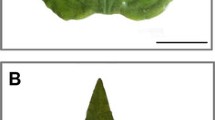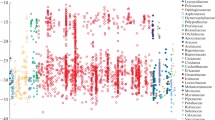Summary
Clusia rosea Jacq. is a hemiepiphyte having Crassulacean Acid Metabolism (CAM). In its natural habitat Clusia begins its life cycle as an epiphyte and eventually becomes a rooted tree. These two stages of the life cycle of Clusia represent markedly different water regimes. Our CO2 exchange, stomatal conductance, titratable acidity, and stable carbon isotope ratio measurements indicate that Clusia has a flexible photosynthetic mode, where CO2 is fixed mostly via CAM during its epiphytic stage, when water availability is low, and via both CAM and C3 during its rooted stage.
Similar content being viewed by others
References
Andre M, Thomas DA, von Willert DJ, Gerhard A (1979) Oxygen and carbon dioxide exchanges in Crassulacean-acid-metabolism-plants. Planta 147:141–144
Benzing DH (1984) Epiphytic vegetation: A profile and suggestions for future inquiries. In: Medina E, Mooney HA, Vasquez-Yanes C (eds) Physiological ecology of plants of the wet tropics. Junk, Hague Boston Lancaster, pp 155–171
Cockburn W, Ting IP, Sternberg LO (1979) Relationship between stomatal behavior and internal carbon dioxide concentration in Crassulacean acid metabolism plants. Plant Physiol 63:1029–1032
Kluge M, Ting IP (1978) Crassulacean Acid Metabolism: Analysis of an ecological adaptation. Springer, Berlin Heidelberg New York
Northfelt DW, DeNiro MJ, Epstein S (1981) Hydrogen and carbon isotopic ratios of the cellulose nitrate and saponifiable lipid fractions from annual growth rings of California redwood. Geochim Cosmochim Acta 45:1895–1898
O'Leary MH (1981) Carbon isotope fractionationi in plants. Phytochemistry 20:553–567
Osmond CB (1978) Crassulacean Acid Metabolism: A curiosity in conetext. Ann Rev Plant Physiol 29:379–414
Ting IP, Lord EM, Sternberg L da SL, DeNiro MJ (1985) Crassulacean acid metabolism in the strangler Clusia rosea Jacq. Science 229:969–971
Ting IP (1985) Crassulacean acid metabolism. Ann Rev Plant Physiol 36:596–614
Williamson JR, Corkie BE (1969) Assays of intermediates of the citric acid cycle and related compounds by fluormetric enzyme methods. In: Colowick JP, Kaplan NO (eds) Methods in enzymology. Vol XIII. Academic Press, New York, pp 434–513
Winter K, Meier GS, Caldwell MM (1986) Respiratory CO2 as carbon source for nocturnal acid synthesis at high temperatures in three species exhibiting Crassulacean acid metabolism. Plant Physiol 81:390–394
Author information
Authors and Affiliations
Rights and permissions
About this article
Cite this article
Sternberg, L.d.S.L., Ting, I.P., Price, D. et al. Photosynthesis in epiphytic and rooted Clusia rosea Jacq.. Oecologia 72, 457–460 (1987). https://doi.org/10.1007/BF00377579
Received:
Issue Date:
DOI: https://doi.org/10.1007/BF00377579




